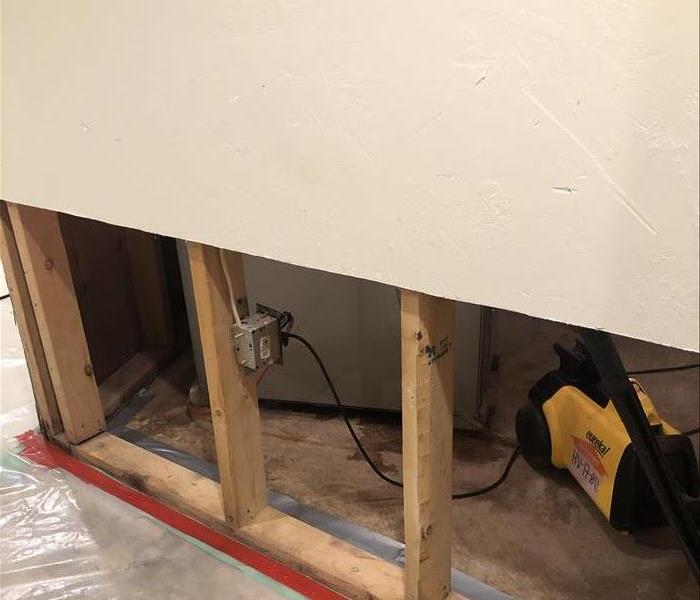Mitigation & Rebuild Processes
8/12/2020 (Permalink)
Did you know that making your water damage disaster “Like it never even happened,” is a two-step process? And that each process is billed separately? The first step is what we call “mitigation”. The second step is what we call “rebuild”.
MITIGATION
The first and most important step is mitigation. The definition of mitigation is: “the action of reducing the severity, seriousness, or painfulness of something”. In the water restoration industry mitigation is the actual drying of your structure in a timely manner, with timely being the key word.
Drying your structure in a timely manner after a water loss is essential to reducing its severity. Timely drying of your structure prevents something we call “secondary damage” and makes it more likely that we will be able to save versus having to remove parts of your structure. When things like wood, drywall, fabric, carpeting, insulation, and so much more get wet, they need to be dried quickly, to prevent the growth of mold and bacteria, wood rot, leaching, and delamination. (Delamination is a mode of failure where a material fractures into layers.) Once these things happen, very often there is no choice but to remove them.
Our goal in the mitigation process is to dry the structure while saving as much of it as we can with as little disruption as possible. That said, the drying process can require the removal of things like woodwork, cabinets, carpet padding, and more, in-order to get air circulating behind and under them.
Drywall is a perfect example. Our first choice is to completely dry drywall in place. In-order to do this, it is important to get air circulating behind the drywall. Drywall can often feel dry to the touch even though it is not. Things like paint can mask the moisture that is hidden on the back side of the drywall. If that happens, mold and bacteria will start to grow on the backside of the drywall and the building will begin to stink and maybe even become unhealthy. We have special meters that can detect moisture hidden deep within. If we detect moisture on the backside of your drywall our first choice will be to dry it in place. We do this by removing the baseboards, drilling holes in the drywall behind the baseboard and putting special low-profile air movers up to the holes to get air circulating behind the drywall. Once the drywall dries, the baseboard can be put back up. The baseboard will cover the holes and the water damage to the drywall will be "Like it never even happened.”
If, however the drywall is too saturated or has been wet for too long, it may need to be removed. But even then, we do it with as little disruption as possible. We only remove drywall that cannot be saved. When the water has come from the ground up like in a flooded basement situation, this often results in something we call a “flood cut”. This is where we cut and remove only the drywall at the bottom 1/3 of the wall or the drywall that cannot be saved.
The second step after mitigation is to “rebuild”, or put back, everything that has been displaced or completely removed in the mitigation process.
REBUILD
During the rebuild phase, things that were displaced or removed are put back or replaced. In our drywall example above, if we were able to dry the drywall in place, the rebuild phase would involve putting the baseboard back up and thereby covering the holes in the drywall. If any drywall could not be saved and had to be removed like in our flood cut example, new drywall is put up, taped, mudded and the wall painted.
It is important to note that these two steps are truly separate and distinct and are even billed separately. The mitigation process is the part that is most necessary. It prevents further damage and preserves the safety of the structure.
Some water restoration companies do not offer rebuild services. We are a full-service restoration company with in-house carpenters and regular subcontractors for all of our customer’s rebuild needs. Once the mitigation process is complete, we will ask you if you want a bid for the rebuild process. While some property owners choose not rebuild at all, do the work themselves, or have a different contractor they prefer to use for construction jobs, many end up doing the rebuild work with us. But much of it depends upon their level of insurance coverage and their own financial situation.
One of the most common problems we see is an inadequate amount of insurance coverage. Many property owners have adequate coverage to pay for the mitigation process, but they do not have enough to cover the rebuild process. If you want your water damage situation to truly be “Like it never even happened,” talk to your insurance agent today to make sure you have adequate coverage to cover both steps.



 24/7 Emergency Service
24/7 Emergency Service
